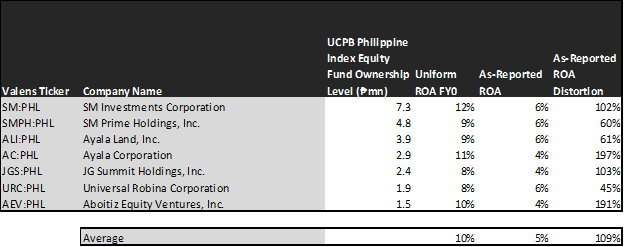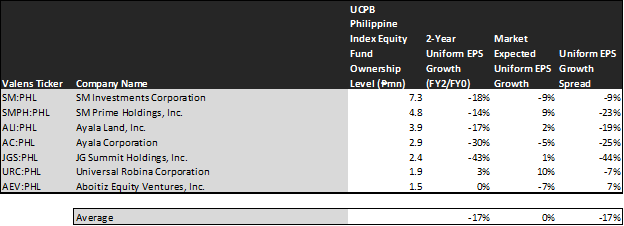This UITF from the first private, Filipino-controlled universal bank may have underperformed PSEi, but its holdings show 2x avg as-reported ROAs

This unit investment trust fund (UITF) from the first private Philippine universal bank has underperformed its benchmark, the Philippine Stock Exchange Index (PSEi), but has also recovered from its pandemic-induced lows.
However, as-reported metrics would leave investors confused as to why the fund would choose to track the index when the stocks in the index appear to have minimal profitability. Uniform Accounting financial metrics help make sense of the fund’s investments.
In addition to examining the fund’s portfolio, we are including the fundamental analysis of one of the fund’s largest holdings, providing you with the current Uniform Accounting Performance and Valuation Tearsheet for that company.
Philippine Markets Daily:
Friday Uniform Portfolio Analytics
Powered by Valens Research
Established in 1963, UCPB was the first private Philippine bank to become a universal bank in the Philippines. After, it obtained its expanded commercial banking license in 1981. Since then, it has grown to become one of the Philippines’ leading universal banks, delivering a full range of expanded commercial banking services to a diversified clientele.
Under UCPB’s financial markets segment are its investment and trust products, which include consumer finance, commercial credit, corporate and investment banking, trust banking, domestic and international trade finance, treasury and money market investment, cash management, and deposit services.
In fact, we’ve written about UCPB’s funds before: UCPB Equity Fund and UCPB High Dividend Fund. This week, we’ll focus on another one of their UITFs, UCPB Philippine Index Equity Fund.
The UCPB Philippine Index Equity Fund (UPIEF) was launched on September 30, 2015. The fund’s strategy is to generate returns that track the Philippine Stock Exchange Index (PSEi), by using the same weights as the index, which consists of the country’s top 30 companies.

UCPB Philippine Index Equity Fund started with a net asset value per unit (NAVPU) of PHP 1.00 at its 2015 inception. Four months later, it dropped to PHP 0.87 in January 2016 due to the global oil price crash. The fund and the PSEi recorded losses of 13% and 12%, respectively.
Afterward, the fund’s NAVPU experienced volatility before rising to a peak of PHP 1.26 in January 2018. The fund’s 45% gain underperformed its benchmark’s 49% gain. However, the fund’s NAVPU fell to PHP 0.98 in November 2018 due to uncertainties regarding Brexit and the U.S.-China trade war. During this period, the UITF’s 22% loss slightly outperformed its benchmark’s 24% loss.
The fund’s NAVPU dropped to its historical low of PHP 0.71 in March 2020 due to the downturn caused by the COVID-19 pandemic. However, the fund has since rebounded with a NAVPU of PHP 1.03 as of January 25, 2021. The fund underperformed its benchmark, with gains of 45% and 53%, respectively.
Looking at UCPB Philippine Index Equity Fund’s investments using as-reported metrics, it is not apparent that the PSEi is composed of stable and established companies.
As-reported metrics would have investors believe that this portfolio consists of companies that do not generate economic profit. However, Uniform Accounting reveals the truth behind these companies.
The table below shows the core non-financial holdings of UCPB Philippine Index Equity Fund along with their Uniform return on assets (ROA), as-reported ROA, and ROA distortion—the difference between Uniform and as-reported ROA.

All of the companies in the UCPB Philippine Index Equity Fund show as-reported ROAs at or below cost-of-capital levels, suggesting that they are not generating economic profit. The fund generated an average as-reported ROA of 5%, slightly below the 6% global corporate average returns.
However, on a Uniform Accounting basis, this UITF’s holdings have actually delivered stronger earnings with an average Uniform ROA of 10%, 2x the as-reported ROA average. These companies have strong returns with all companies having Uniform ROAs greater than global average returns.
The Uniform Accounting framework addresses financial statement inconsistencies attributable to the flaws present in the Philippine Financial Reporting Standards (PFRS). This enables investors to determine the true underlying performance of companies and avoid distorted financial analysis and valuation.
As such, it should not be surprising that when analyzing the non-financial holdings of the fund, the figures that easily stand out are the large discrepancies between Uniform ROA and as-reported ROA for these companies.
While at a glance, the difference between as-reported ROA and Uniform ROA may not seem that great, the distortion in percentage ranges from 45% to 197%, with Ayala Corporation (AC:PHL), Aboitiz Equity Ventures, Inc. (AEV:PHL), JG Summit Holdings, Inc. (JGS:PHL), and SM Investments Corporation (SM:PHL) all having distortions of more than a hundred percent.
As-reported metrics are understating the profitability of Ayala Corporation, suggesting a below-average company with an as-reported ROA of 4%. In reality, it is a high-quality firm with an 11% Uniform ROA, consistently generating returns of at least 9% over the past decade.
Likewise, Aboitiz is not just a 4% ROA firm like what as-reported numbers suggest. It is an above-average company with a 10% Uniform ROA. Furthermore, over the past decade, Aboitiz has never seen its Uniform ROA dip below 10%.
By focusing on as-reported metrics alone, these companies look like anything but profitable businesses.
That said, looking at profitability alone is insufficient to deliver superior investment returns. Investors should also identify if the market is significantly undervaluing the company’s earnings growth potential.

This table shows the earnings growth expectations for the major non-financial holdings of the fund. It features three key data points:
- The two-year Uniform earnings per share (EPS) growth represents the Uniform earnings growth the company is likely to have for the next two years. The earnings number used is the value of when we convert consensus sell-side analyst estimates to the Uniform Accounting framework.
- The market expected Uniform EPS growth represents what the market thinks Uniform earnings growth is going to be for the next two years. Here, we show by how much the company needs to grow Uniform earnings in the next two years to justify the current stock price of the company. This is the market’s embedded expectations for Uniform earnings growth.
- The Uniform EPS growth spread is the difference between the 2-year Uniform EPS growth and market expected Uniform EPS growth.
On average, Philippine companies are expected to have 6% annual Uniform earnings growth over the next two years. Meanwhile, UCPB Philippine Index Equity Fund’s major holdings are forecast to underperform with a 17% projected Uniform earnings shrinkage in the next two years, while the market is seeing an immaterial Uniform earnings growth.
Among these companies, only Aboitiz Equity Ventures, Inc. (AEV:PHL) has a positive Uniform earnings growth spread.
The market is pricing Aboitiz’s Uniform Earnings to shrink by 7% in the next two years. However, sell-side analysts are projecting the company’s earnings to have immaterial growth.
Overall, as-reported numbers would have investors incorrectly conclude that this portfolio consists of low-quality companies. While these firms suffer from the adverse effects of the coronavirus pandemic, dragging down their short-term earnings growth expectations, Uniform Accounting metrics show that these mature, low growth, but high return companies have intact business models that should drive economic profitability moving forward.
SUMMARY and Ayala Corporation Tearsheet
Today, we’re highlighting one of the largest individual stock holdings in the UCPB Philippine Index Equity Fund—Ayala Corporation (AC:PHL).
As the Uniform Accounting tearsheet for Ayala Corporation highlights, it trades at a Uniform P/E of 20.0x, below the global corporate average of 25.2x but around its historical average of 18.7x.
Low P/Es require low, and even negative, EPS growth to sustain them. In the case of Ayala Corp., the company has recently shown a 308% Uniform EPS growth.
Sell-side analysts provide stock and valuation recommendations that poorly track reality. However, sell-side analysts have a strong grasp on near-term financial forecasts like revenue and earnings.
We take sell-side forecasts for Philippine Financial Reporting Standards (PFRS) earnings as a starting point for our Uniform earnings forecasts. When we do this, Ayala Corp.’s sell-side analyst-driven forecast shows that Uniform earnings are expected to shrink by 73% in 2020 and grow by 83% in 2021.
Based on the current stock market valuations, we can back into the required earnings growth rate that would justify PHP 809.50 per share. These are often referred to as market embedded expectations.
The company can have Uniform earnings shrink by 5% over the next three years and still justify current price levels. What sell-side analysts expect for Ayala Corp.’s earnings growth is below what the current stock market valuation requires in 2020, but above that requirement in 2021.
The company has an earning power around 2x long-run corporate averages, and which has consistently been well above global long-run corporate averages. Ayala Corp.’s cash flows and cash on hand also exceed obligations in the next five years. However, based on operating risk and refinancing capability, the company has an intrinsic credit risk of 140bps. This indicates that Ayala Corp. has a low dividend risk and moderate credit risk based on their refinancing capability.
To conclude, Ayala Corp.’s Uniform earnings growth is below peer averages, but is trading around peer average valuations.
About the Philippine Market Daily
“Friday Uniform Portfolio Analytics”
Investors who don’t engage in the buying or selling of securities for a living oftentimes rely on professionals to manage their own investments within the scope of their investment policies.
With so many funds and managers out there, it can get confusing and difficult to decide which one best suits your needs as an investor.
Every Friday, we focus on one fund in the Philippines and take a deeper look into their current holdings. Using Uniform Accounting, we identify the high-quality stocks in their portfolio which may not be obvious using the as-reported numbers.
We also identify which holdings may be problematic for the fund’s returns that they would need to reconsider from a UAFRS perspective.
To wrap up the fund analysis, we highlight one of their largest holdings and focus on key metrics to watch out for, accessible in our tearsheets.
Hope you’ve found this week’s focus on UCPB Philippine Index Equity Fund interesting and insightful.
Stay tuned for next week’s Friday Uniform Portfolio Analytics!
Regards,
Angelica Lim
Research Director
Philippine Markets Daily
Powered by Valens Research
www.valens-research.com




